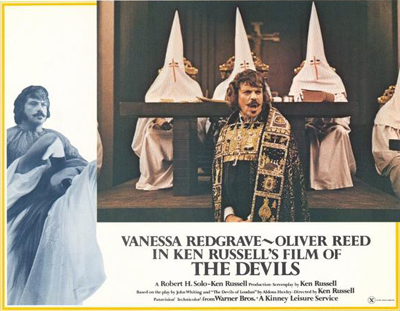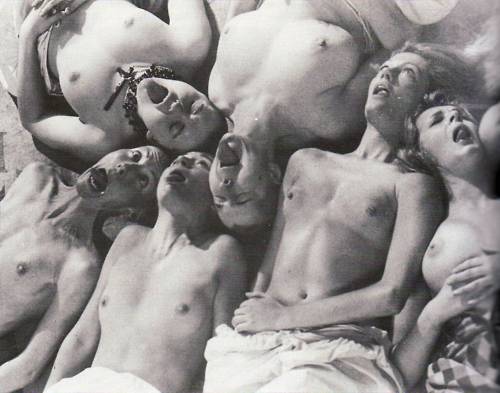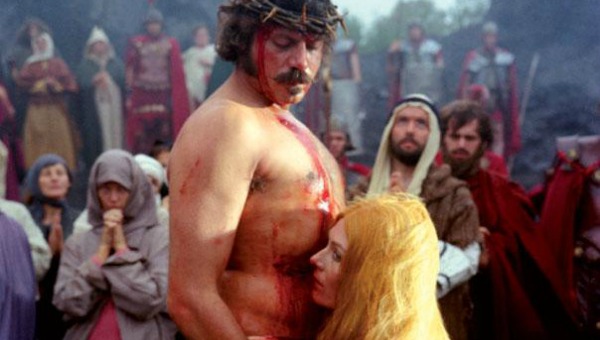 In many ways, Father Grandier’s last moments in THE DEVILS sum up the derision and persecution associated with the film itself. As the flames lick around him, still the priest protests his innocence from the stake amid the crowd’s cries of malevolence. Finally, over forty years since its initial opening, Ken Russell‘s towering creation emerges from its enforced purgatory.
In many ways, Father Grandier’s last moments in THE DEVILS sum up the derision and persecution associated with the film itself. As the flames lick around him, still the priest protests his innocence from the stake amid the crowd’s cries of malevolence. Finally, over forty years since its initial opening, Ken Russell‘s towering creation emerges from its enforced purgatory.
This March saw the release of the 1971 original X-rated cut of one of Britain’s most controversial films. Refused a DVD release by the Warner Bros, the breakthrough comes on the back of a long campaign from the BFI, supported by notable individuals such as Mark Kermode. However, for those involved in production, the road to distributing platforms began much, much earlier.
Opening on the 19th May 1971, Russell’s film was divisive from the start. Alex Walker, critic for the Evening Standard at the time of release, rubbished the film – which famously led to a physical confrontation with the director on the BBC late night news program, Russell claiming two fabrications on Walker’s part. However, the audience reception, at least in part, was to prove far more incendiary, with the word “satanic” being thrown left, right and centre at the film and its creator. Banned in Glasgow, Blackpool, Tunbridge Wells and (heaven forbid!!) Cambridge, the film received a short but fiery life before being condemned to the shadowy archives by Warner Bros, where significant extracts were lost for over 30 years.
So why all the fuss? Well, firstly the film charters the always choppy waters of religious atrocities. Drawn predominantly from Aldous Huxley’s “Devils of Loudon” and John Whiting’s play of the same name, Russell interprets a jaw-dropping true account of a 17th century French witch hunt. Iron willed and explosively inspiring, Father Grandiers (played by Oliver Reed in arguably his greatest performance) controls Loudon, an important fortress town in Poitiers, sought to be brought under central authority by the scheming Cardinal Richelieu (Logue). Although sexually promiscuous, Grandiers finds love and meaning in the innocently pious Madelaine (Jones), much to the disappointment of Sister Jeanne (Redgrave) and her lustful convent. 
… the naked nuns flagellate their way through an exorcism in front of a baying crowd …
The walls of Loudon are all important. Forcefully recruiting the nunnery in a conspiracy, Richelieu selects the possessed Father Pierre Barre (Gothard) to propagate a charge of possession by the devil against Grandiers. This leads to the debasement of both the church and its followers. Famously, the naked nuns flagellate their way through an exorcism in front of a baying crowd, symbolising the crowning moment of what Russell described as “the unholy marriage of church and state.”
The number of stunning contributions denies any one person to be described as stand-out. Russell’s direction and sheer commitment to pushing ideas to the limit rightfully earns him the title of an “appalling talent” – in all the best possible ways. The performances of Reed and Redgrave are flawless in their depiction of two of British cinemas most conflicted characters. The score of Peter Maxwell Davies, who at this time was a début film composer, clinches the feeling of grand disaster perfectly. And spare a thought for the extras who each deserve a statue for their commitment – more than half of which is not seen in this cut.
A scan across time that could be as much about the “brainwashing”of the TV age as the 17th century.
However it is the set design of Derek Jarman that really moves the film to genius. Introduced to Russell by a friend, who met Jarman on a chance encounter on a train from Paris, the artist was recruited to form all of the sets and costumes for the film including the life-size models of Loudon’s walls, built at Pinewood Studios. Working on his first film set, Jarman creates a stunning palette of contrasts. Actor Melvin later described the vision as “a colour film in black and white”. Classic and contemporary both find a place amidst Richelieu’s archives and Loudon’s Chapel, which have tones of Gothic mixed with avant-garde. It is this synthesis that brings universality to Russell’s themes. A scan across time that could be as much about the “brainwashing”of the TV age as the 17th century.
“The Devils” is one of British cinema’s greatest pillars, which is a hollow statement considering that this edition is not as Russell intended. In truth, the UK X-rated cut is a hobbled and emasculated version of the directors original vision. Capping a five month process of back and forth from the censors and Warner Bros, the film was left with a long list of reductions, including the infamous centrepiece, the “Rape of Christ” sequence, depicting naked women masturbating over the the statue of Jesus. Upon its first delivery to the board of censors, John Trevelyn, secretary for the BBFC and supporter of the film, spoke to Russell praising his masterpiece but admitting it could not possibly get through without cuts. However, even before the censors remarks, the studio executives released their own collections of imposed changes, highlighting in particular sexual acts committed by nuns. Three further trials over reductions resulted in more cuts, however. Russell remarked afterwards that they were “some of the most mind-blowing scenes ever censored” and that the film was “damaged … it had been damaged good.” Yet given how close the film came to not being released at all, those in production reservedly accepted. Many of the cut scenes, including “the Rape of Christ” were then believed to be lost, only to be found thirty years later.
“it raises the question of whether artistic quality justifies total freedom.”
Obviously, given the sad passing of Ken Russell last year, this March release is marred. However, some consolation can be found in his knowledge that what he described as “his only political film” would finally receive a DVD release. Yet the questions posed by the director and his greatest work live on. Trevelyn commented to his colleagues upon first viewing, “it raises the question of whether artistic quality justifies total freedom.” Given the partisan nature of this article, one might be able to guess where my opinions lie. However, regardless of your stance, respect must be shown to the fact that forty years on, “The Devils” continues to pose the question. It is hard to imagine anyone calling for the censored film of our generation (say HUMAN CENTIPEDE II) to be reviewed forty years from now. In my mind it can only be a matter of time before a posthumous directors cut of Russell’s finest film is available: and we should all look forward to the day when the true DEVILS rises.

